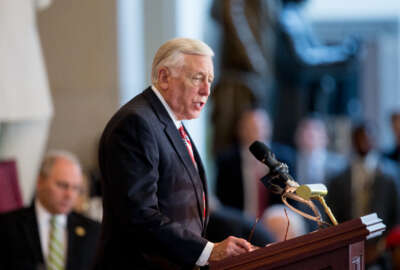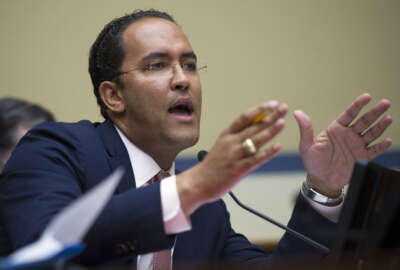

Rep. Gerry Connolly (D-Va.) is supporting both the centralized and decentralized approaches to address the need to get rid of legacy technology systems.
Rep. Gerry Connolly (D-Va.) believes agencies can have their cake and eat it too when it comes to IT legacy modernization.
Connolly is supporting both the $3.1 billion IT Modernization Fund (ITMF) developed by the Obama administration and introduced in the House by Rep. Steny Hoyer (D-Md.), and the MOVE-IT Act introduced July 14 by Rep. Will Hurd (R-Texas) and Sens. Tom Udall (D-N.M.) and Jerry Moran (R-Kan.).
The Modernizing Obsolete and Vulnerable Enterprise IT (MOVE-IT) Act would create working capital funds in each agency as part of a decentralized approach to addressing the growing problem of legacy IT systems across the government.
Connolly’s co-sponsorship of the MOVE-IT Act along with his vocal support of the ITMF created an “only in DC” optics problem, which he quickly tried to address in an internal memo to Hoyer trying to explain how both of these bills could work together.
“We appreciate the leadership of Whip Hoyer on federal IT and workforce issues. Rep. Connolly is proud to cosponsor H.R. 4897, the IT Modernization Act, which will create a revolving fund, using a $3 billion appropriation from the Treasury, to replace legacy systems with priority given to those identified as high risk and having government-wide impacts. This legislation is critical for not only getting agencies to realize the urgency of replacing legacy systems with more sustainable and secure IT solutions but also incentivizing them to act,” Connolly wrote in the memo, which Federal News Radio obtained.
Connolly also said that he’s been in discussions with other members and industry on how best to spur a broader adoption of cloud computing.
“Such a proposal was first discussed during the drafting and amending of the Federal Information Technology Acquisition and Reform Act (FITARA), which Rep. Connolly co-authored, but it was not included in the final bill,” he wrote. “H.R. 5792, the Modernizing Outdated and Vulnerable Equipment and Information Technology (or MOVE IT) Act, revives that proposal by allowing agencies to create working capital funds, which could be funded through approved reprograming or transfers of other IT dollars or from savings realized under FITARA implementation. The bill also codifies efforts to streamline the Federal Risk Authorization and Management Program (FedRAMP) certification process for cloud service providers.”
The internal memo, otherwise, focused on going through the different aspects of the two bills as well as FITARA, but really didn’t highlight the differences in the legislation, or why they would be complementary.
Dave Marin, a former staff director of the House Oversight and Government Reform Committee, said both bills are trying to solve the “under examined challenge and threat” of old technology systems.
“This is not a partisan exercise. Both Republicans and Democrats will bear the political burden of the consequences of failure. The fact is, you can count on two hands the number of members of Congress who fully grasp the challenge and potential solutions. You see some of them anchoring these bills, including Mr. Hurd and Mr. Connolly,” said Marin, who now is managing principal for Podesta Group Public Relations in Washington. “So I view positively the fact there are now complementary legislative proposals, and the fact they are getting bipartisan support out of the gate. This isn’t Mr. Connolly seeking to have his cake and eat it too; it’s Mr. Connolly addressing the problem holistically and seeking opportunities to move the conversation forward in multiple, complementary ways.”
Connolly may be trying to play both sides of the IT modernization game.
On one hand, he is making nice to the White House and supporting the centralized IT fund that would address a long-standing problem and promote shared services. Be careful not to make your friends in the executive branch angry.
On the other hand, he is making nice to industry by supporting the MOVE-IT Act, which creates opportunities in each agency through a decentralized funding approach that’s based on savings accrued by closing data centers, consolidating software licenses and a host of other steps. Be careful not to make your friends in industry unhappy or something bad could happen the next time you run for reelection.
Connolly said in a statement to Federal News Radio that while the bills are different, they also are complementary.
“In particular, the IT Modernization Act will make a significant upfront investment to retire vulnerable, large-scale legacy systems affecting multiple agencies. While most agencies will no doubt submit worthy applications seeking support from the fund, not all projects will be funded immediately,” he said in an email. “That’s where the MOVE IT Act would fill a supplemental role by allowing agencies, on a much smaller scale, to reinvest savings generated through FITARA reforms to make investments in cloud transition. That supports the overall goal for all three pieces of legislation to modernize and strengthen federal IT systems.”
By supporting both proposals, Connolly is playing the odds of coming out on top no matter which proposal or what is more likely to occur, some hybrid approach emerges.
There is growing doubt on industry’s side that the ITMF is going anywhere. Several industry sources tell me their big concerns are with the $100 million of the $3.1 billion fund that is slated for the General Services Administration.
Among the biggest concerns in Hoyer’s bill is the control GSA would get to make decisions about the projects that get funding, and how GSA would manage the money.
For instance, the ITMF bill would let the GSA administrator, in consultation with the Office of Management and Budget director, establish terms of repayment to the fund by agencies receiving money. If the customer agency can’t or doesn’t pay back the ITMF “loan,” then GSA could get the money back by the issuance of a transfer or counter-warrants.
GSA also would have the authority to transfer money only when they see fit based on incremental development activities. And the oversight board would “make recommendations” to GSA of modernization proposals, but in the end GSA seems to have the final decision.
These and several other provisions are creating doubt into this centralized approach, and opening the door for Hurd’s decentralized working capital fund proposal.
Federal Chief Information Officer Tony Scott said in as Congress went out for the month-long recess that discussions around the ITMF continue to happen and more are needed when lawmakers return in September.
Connolly’s point is fair that the ITMF would only address a small percentage of the legacy systems that need help. And he’s correct in understanding that over the long term, giving agencies an incentive to keep money by reducing the cost of IT is important too.
So maybe playing down the middle by supporting both bills, Connolly has the foresight that both OMB and some of his fellow lawmakers don’t have on how best to fix this ever-growing legacy IT problem.
The question is whether others will be able to find the good in both approaches and turn them into law.
Copyright © 2025 Federal News Network. All rights reserved. This website is not intended for users located within the European Economic Area.
Jason Miller is executive editor of Federal News Network and directs news coverage on the people, policy and programs of the federal government.
Follow @jmillerWFED


